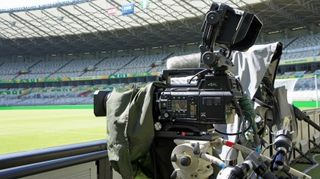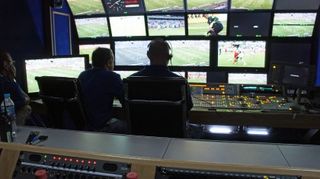Shooting for the future: the hidden challenge of the World Cup final
Behind the scenes at the biggest game in football
The next generation of TV is already with us: 4K or Ultra HD is slowly creeping its way into our living rooms, although there's hardly any content to watch on these gargantuan sets yet.
This is why Sony is risking an experiment at an event such as this, proving that it can shoot this pivotal game in 4K and broadcast it back in real time to TV networks around the globe.
There are a number of local broadcasters taking the UHD feed, such as the BBC in the UK, but most are using it to see how whether 4K live TV can actually work, such is the technical step up in bringing the crystal clear pictures across.

That explains why there's a separate control centre dedicated just to the 4K signal – a cramped air-conditioned van in the car park outside the stadium.
It might be a tight fit, but inside it will be putting out proof that UHD broadcasting can work from this control centre.
The team might have a wealth of high end equipment to help create the show, but they also have to slip alongside the main broadcasters in the stadium to use the next generation cameras.
And while they'll get help from HBS, Coleman told us that trialling a new tech was understandably far from the main worry: "The world's feed is my priority and I treat 4K as a welcome guest, but low on the list."
Get daily insight, inspiration and deals in your inbox
Get the hottest deals available in your inbox plus news, reviews, opinion, analysis and more from the TechRadar team.
Not that that bothers Robert Thorne, Sony's business development engineer. "From Sony's point of view, 4K and HD are equally important. It's on the same level. HBS are providing the HD feed, so that's their priority."

He seems relaxed about the trial despite the enormous importance on the game, and that's partly because he's been here before: Sony filmed the Confederations Cup, a warm-up tournament for the World Cup, last year in 4K too.
"Compared to what we did in Belo Horizonte [for the Confederations Cup] this is a finished product we're producing. That was more of a trial, and was only used internally."
Why can't I watch it too?
But if this show is being produced like any other live event, and TVs capable of showing it are appearing in living rooms across the world, why is it being kept behind closed doors?
"No-one is showing it because there's no mechanism," said Thorne. "The issue is the set top boxes; the encoders [to transmit 4K] exist, but it's the global distribution of the content to the home that the tricky part, slowing [adoption] down.
"That's why events like this are needed, as it allows broadcasters – like the BBC – to do tests."

The good news for those itching for a new level of clarity on their TV is there are other ways of getting the content. Netflix is starting to produce some of its shows in Ultra HD, and while it doesn't show live TV it's still an option for broadcasters in the future.
Thorne confirmed it was something Sony had looked at, but said that it still depended on a number of factors.
"There's just so much data, and [viewers would] need a stable bandwidth" he said, before explaining why it wasn't used at this tournament. "With an event like this you start planning four years ago, so not knowing what the technology is going to be like at the cutting edge."

If you want to see the World Cup in 4K, your options are limited. You could have caught the highlights that were sent back to the UK for retailers to show on the new TVs, or you can wait for the official film of the World Cup, which will be shown in 4K.
This mirrors what was done with HD filming a few years ago, and even if 4K does go the way of 3D and fizzle out, this trial will still make the pictures on your current hi-def screen look much better.
Both Coleman and Thorne confirmed that the new lenses and systems trialled for UHD quickly filter down to making the 'normal' HD picture look even crisper.
And don't think 4K is the only advanced trial here: Japanese broadcasters are filming in 8K, which some believe will be an even more futuristic standard, and Fifa is also shooting the World Cup final in 360 degrees, with the intention of using that experience for tablets and phones to give an integrated feel.
So when you're watching the final, remember you're not just seeing another botched penalty decision or welcome offside flag, you're seeing the fruits of years of labour... and quite possibly a pivotal moment in the future of TV.

Gareth has been part of the consumer technology world in a career spanning three decades. He started life as a staff writer on the fledgling TechRadar, and has grown with the site (primarily as phones, tablets and wearables editor) until becoming Global Editor in Chief in 2018. Gareth has written over 4,000 articles for TechRadar, has contributed expert insight to a number of other publications, chaired panels on zeitgeist technologies, presented at the Gadget Show Live as well as representing the brand on TV and radio for multiple channels including Sky, BBC, ITV and Al-Jazeera. Passionate about fitness, he can bore anyone rigid about stress management, sleep tracking, heart rate variance as well as bemoaning something about the latest iPhone, Galaxy or OLED TV.
